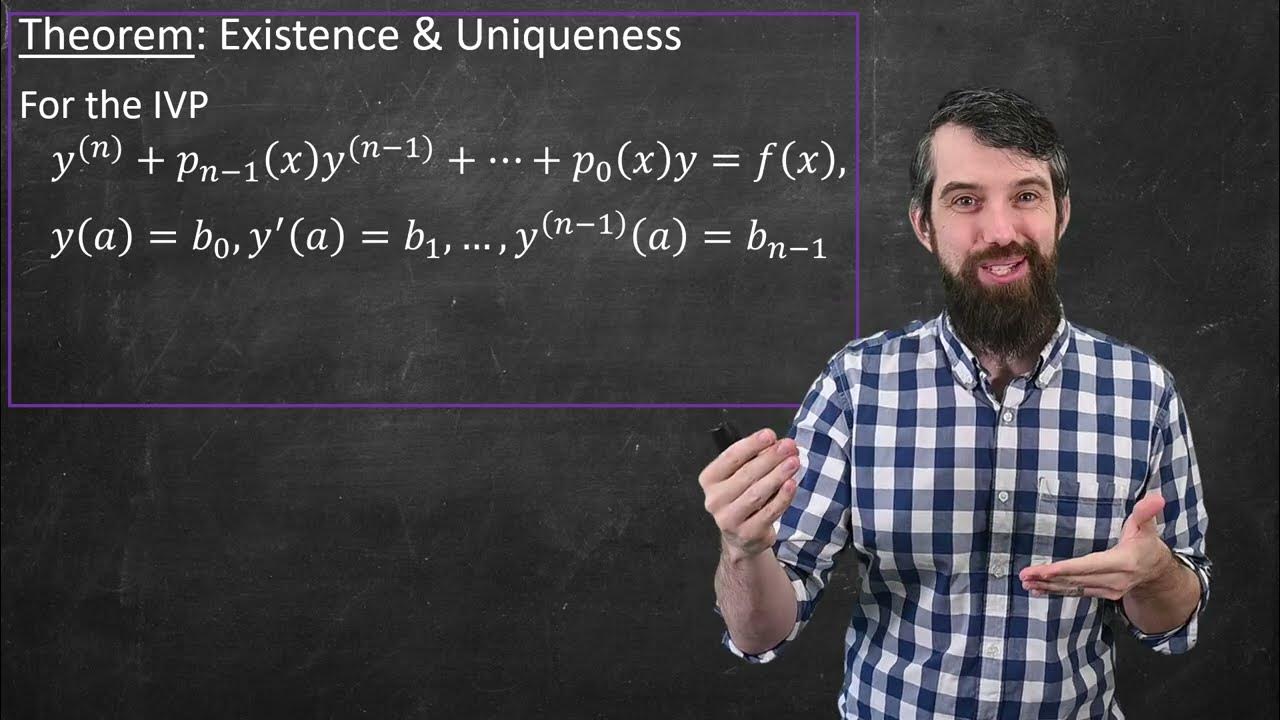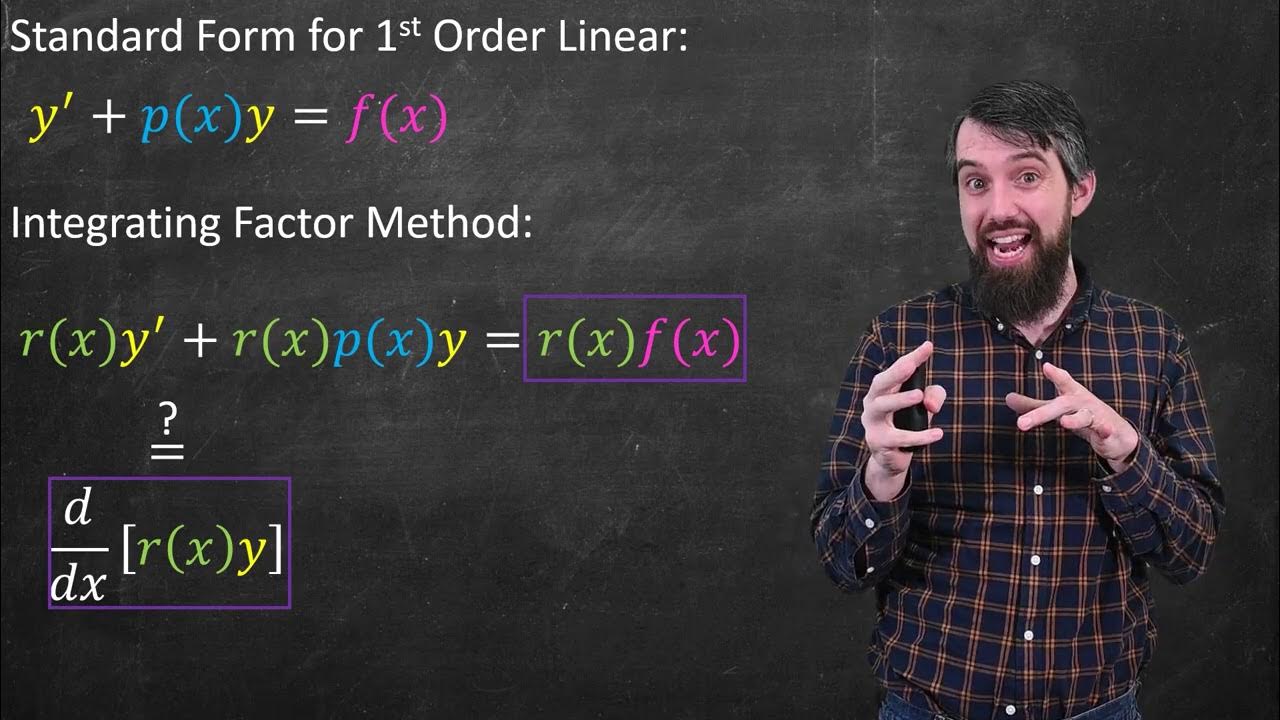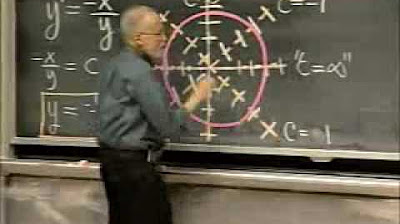The Theory of 2nd Order ODEs // Existence & Uniqueness, Superposition, & Linear Independence
TLDRThe video script delves into the theory behind second-order linear differential equations, extending concepts from first-order equations. It emphasizes that these equations are characterized by the highest derivative being second-order and variables appearing to the power of one. The video introduces the concept of a homogeneous second-order linear differential equation, where the right-hand side function is zero. It discusses the existence and uniqueness theorem, which assures that under certain conditions, solutions exist and are unique. A key principle explored is the superposition, which allows for any linear combination of two solutions to also be a solution. The script also touches on the importance of linear independence between solutions, stating that if two solutions are linearly independent, any solution to the homogeneous equation can be expressed as a linear combination of these two. The example of y'' + y = 0 is used to illustrate this, with sine and cosine of x identified as linearly independent solutions, leading to the general solution being a combination of c1 sine x and c2 cosine x. The video concludes by noting the increased complexity in solving second-order differential equations compared to first-order, where methods like the integrating factor always yield a solution.
Takeaways
- 📚 The video discusses the theory behind second-order linear differential equations, extending concepts from first-order equations.
- 🔢 Second-order linear differential equations have the highest derivative of 2, with y, y', and y'' all to the power of 1.
- 📉 The terms 'homogeneous' refers to when the function f(x) on the right-hand side of the equation equals zero.
- 🌟 An existence and uniqueness theorem for second-order linear differential equations is presented, similar to that for first-order equations, requiring p, q, and f to be continuous.
- 🤝 The principle of superposition is introduced, stating that any linear combination of two solutions to a homogeneous equation is also a solution.
- 🧵 Linear independence of solutions y1 and y2 is defined, meaning they are not scalar multiples of each other on an interval.
- 🔑 If y1 and y2 are linearly independent solutions to a homogeneous linear differential equation, any solution can be written as a linear combination of these two.
- 🌌 The general solution to the example equation y'' + y = 0 is given by c1 * sin(x) + c2 * cos(x), assuming y1 = sin(x) and y2 = cos(x) are the solutions.
- 🔍 The existence and uniqueness theorem guarantees a unique solution given initial conditions for y and y'.
- 🛠️ The video highlights the loss of a universally applicable method for solving second-order differential equations compared to first-order, such as the integrating factor method.
- 📈 The challenge increases with higher-order differential equations, often requiring more specific methods and assumptions for solutions.
Q & A
What is a second-order linear differential equation?
-A second-order linear differential equation is an equation where the highest derivative is of the second order, and the variables y, y' (y prime), and y'' (y double prime) all appear with a power of 1. The coefficients can be functions of the independent variable x, and the equation is linear if y and its derivatives are to the power of 1.
What is the significance of a homogeneous second-order linear differential equation?
-A homogeneous second-order linear differential equation is one where the function on the right-hand side, f(x), is zero. This means that the equation does not include any non-homogeneous terms or forcing functions, simplifying the analysis and solutions.
What does the existence and uniqueness theorem for second-order linear differential equations state?
-The existence and uniqueness theorem for second-order linear differential equations states that if the functions p(x), q(x), and f(x) are continuous on an interval I containing a point a, and given initial conditions y(a) = b0 and y'(a) = b1, then there exists a unique solution to the differential equation on the interval I.
What is the principle of superposition in the context of homogeneous linear differential equations?
-The principle of superposition states that if y1 and y2 are solutions to a homogeneous linear differential equation, then any linear combination of these solutions (c1*y1 + c2*y2, where c1 and c2 are constants) is also a solution to the original equation.
What does it mean for two solutions y1 and y2 of a differential equation to be linearly independent?
-Two solutions y1 and y2 are linearly independent if they are not scalar multiples of each other. This means that one solution cannot be expressed as a constant times the other solution over an entire interval.
How does linear independence of solutions apply to the general solution of a homogeneous linear differential equation?
-If y1 and y2 are linearly independent solutions to a homogeneous linear differential equation on an interval, then any solution to the equation on that interval can be expressed as a linear combination of y1 and y2. This implies that once you have found two linearly independent solutions, you have effectively found the general solution.
What is the general solution to the differential equation y'' + y = 0?
-The general solution to the differential equation y'' + y = 0 is given by c1*sin(x) + c2*cos(x), where c1 and c2 are constants that can be determined based on initial conditions.
Why is the method of solving first-order linear differential equations different when dealing with second-order or higher-order equations?
-The method of solving first-order linear differential equations, such as the integrating factor method, does not always apply to second-order or higher-order equations. As the order of the differential equation increases, the methods to solve them become more challenging and less general, often requiring specific techniques for particular forms of the equation.
What is the integrating factor method?
-The integrating factor method is a technique used to solve first-order linear differential equations. It involves finding a function that is used to make the left side of the differential equation exactly the derivative of a product of the integrating factor and the original function.
How does the existence and uniqueness theorem relate to initial conditions in second-order differential equations?
-The existence and uniqueness theorem for second-order differential equations requires two initial conditions: one for the value of y at a point a (y(a) = b0) and another for the value of the first derivative y' at the same point (y'(a) = b1). These initial conditions are crucial for determining the unique solution that exists on the interval where the coefficients are continuous.
What is a limitation when moving from first-order to second-order differential equations in terms of general methodologies?
-A limitation when moving from first-order to second-order differential equations is the loss of powerful general methodologies that always work, such as the integrating factor method for first-order equations. For second-order and higher-order equations, there is often no single method that can solve all types of equations, and solutions may require more specific or restrictive assumptions.
Outlines
📚 Introduction to Second Order Linear Differential Equations
This paragraph introduces the topic of second order linear differential equations, emphasizing that they are characterized by their highest derivative being of order 2 and that the dependent variable y and its derivatives appear to the power of 1 with coefficients that may be functions of the independent variable x. It also explains the concept of a homogeneous second order linear differential equation, where the right-hand side function f(x) is zero. The paragraph further discusses the existence and uniqueness theorem for these equations, which is similar to the one for first order differential equations, and requires the functions p(x), q(x), and f(x) to be continuous. The theorem states that given two initial conditions (one for y and one for its derivative), there exists a unique solution to the differential equation on the interval where the functions are continuous.
🧩 The Principle of Superposition and Linear Independence
The second paragraph delves into the principle of superposition, which is unique to second or higher order differential equations. It states that if y1 and y2 are solutions to a homogeneous linear differential equation, then any linear combination of these solutions (c1*y1 + c2*y2) is also a solution. The paragraph explains that the derivative is a linear operator, allowing for the distribution of derivatives inside brackets. The concept of linear independence is introduced, where two solutions are considered linearly independent if they are not scalar multiples of each other. The heart of the matter is a theorem stating that if y1 and y2 are linearly independent solutions to a homogeneous linear differential equation, then any solution to this equation can be expressed as a linear combination of y1 and y2. This theorem provides a stopping point for finding solutions, as once two independent solutions are found, all other solutions can be written in terms of them.
🔍 The Challenge of Solving Second Order Differential Equations
The final paragraph addresses the challenges that come with solving second order differential equations compared to first order ones. It contrasts the integrating factor method used for first order linear differential equations, which always works and guarantees a unique solution, with the more complex nature of second order equations. The paragraph acknowledges that as the order of differential equations increases, the general methodologies that always work become less powerful. It suggests that for second order and higher, specific methods must be developed for differential equations with more restrictive assumptions. The speaker also hints at future videos that will explore these methods in more detail.
Mindmap
Keywords
💡Second-order linear differential equations
💡Existence and uniqueness theorem
💡Initial conditions
💡Homogeneous differential equations
💡Principle of superposition
💡Linear independence
💡Linear combination
💡Continuous functions
💡
💡Derivative
💡General solution
💡Integrating factor method
Highlights
The video discusses the theory behind second-order linear differential equations, extending concepts from first-order linear differential equations.
Second-order linear differential equations are characterized by their highest derivative being 2 and variables y, y', and y'' all appearing to the power of 1.
If the function f(x) on the right-hand side is zero, the equation is called a homogeneous second-order linear differential equation.
Existence and uniqueness theorem for second-order linear differential equations is presented, similar to that for first-order equations.
The theorem requires the functions p, q, and f to be continuous on an interval containing the initial condition.
The principle of superposition is introduced, stating that any linear combination of two solutions to a homogeneous linear differential equation is also a solution.
The derivative is a linear operator, allowing for the distribution of derivatives inside brackets when taking derivatives of a linear combination of functions.
Two solutions y1 and y2 are considered linearly independent if they are not scalar multiples of each other on an interval.
The heart of the theory is that any solution to a homogeneous linear differential equation can be written as a linear combination of two linearly independent solutions y1 and y2.
The theorem implies that if two independent solutions are found, no other independent solutions exist for the differential equation.
An example is provided with the differential equation y'' + y = 0, where sine and cosine are shown to be linearly independent solutions.
The general solution to the example equation is given by c1 * sine(x) + c2 * cosine(x), where c1 and c2 are constants determined by initial conditions.
The video contrasts the integrating factor method for first-order linear differential equations, which always works, with the increased complexity for second-order equations.
For second-order and higher differential equations, general methodologies that always work may not be available, requiring more specific methods for particular types of equations.
The video concludes by indicating that future videos will explore more methods for solving second-order differential equations.
The presenter encourages viewers to like the video and leave comments with questions for further discussion.
Transcripts
Browse More Related Video

The Theory of Higher Order Differential Equations

Linear Differential Equations & the Method of Integrating Factors

Separation of Variables // Differential Equations

Lec 1 | MIT 18.03 Differential Equations, Spring 2006

Reducible Second Order Differential Equations, Missing Y (Differential Equations 26)

Converting a Higher Order ODE Into a System of First Order ODEs
5.0 / 5 (0 votes)
Thanks for rating: